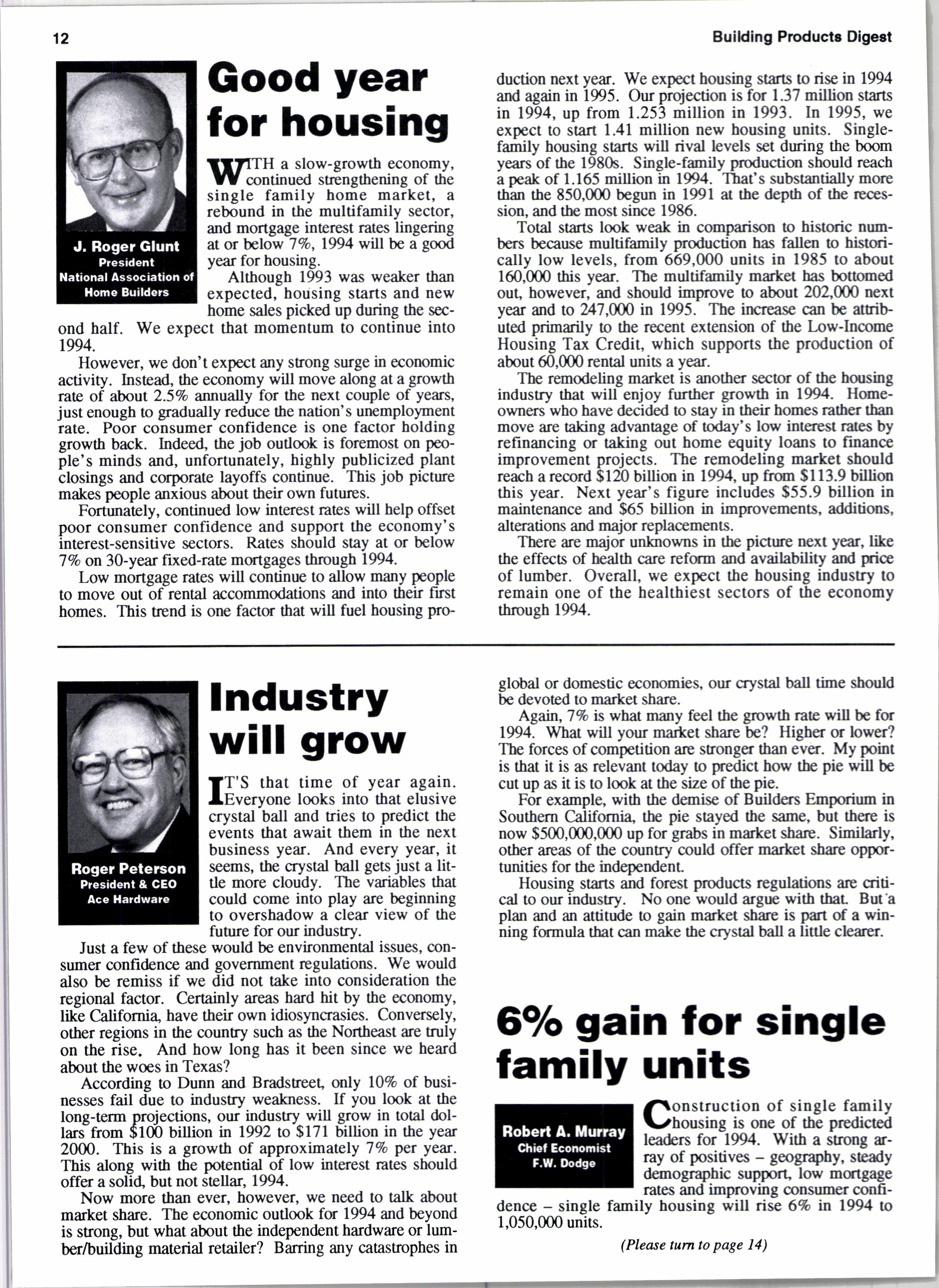
3 minute read
Industry will grow
fT'S that time of year again.
IEveryone looks into that elusive crystal ball and tries to predict the events that await them in the next business year. And every year, it s€ems, the crystal ball gets just a little more cloudy. The variables that could come into play are beginning to overshadow a clear view of the fufire for our industry.
duction next year. We expect housing sttrts to rise in 1994 and again in 195. Our projection is fu 1.37 million strts in 1994, up from 1.253 million in 1993. In 1995, we expect to start 1.41 million new housing units. Singlefamily housing starts will rival levels set duing the bomt years of the 1980s. Single-fmily producrion should reach a peak of 1.165 million in 1994. That's subsuntially mce than the 850,m0 begun in l99l at the depth of the recession, and tbe most since 1986.
Total strts look weak in comparison o histmic numbers because multifnmily production bas fallen to historically low levels, from 669,000 units in l9E5 to about 160,000 this year. The multifamily market has bottmed out, however, and should imp'rove to about 2(D,0(X) rext year and to U1,W in 1995. The inctease can be anrib uted primrily to the recent extension of tbe low-Income Housing Tax Credit, which supports the production of about 60,000 rental units a year.
Tbe remodeling maket is anotber sector of tbe bousing industry that will enjoy finther growth in 1994. Honeowners who have decid€d to stay in their homes raber rhen move are tekinS advantage of today's low interest raes by refinancing 66 rrking out home equity loans to finance improvement projects. The remodeling market should reach a record $120 billion in 1994, up ftm $If 3.9 billion this year. Next year's figure includes $55.9 billion in maintenance and $65 billion in improvements, additions, alterations and major replaoements.
There are m4ior unlrrowns in the picture n€xt year, like the effects of bealth care refam and availability and ftce of lumber. Overall, we expect the housing industry to remain one of the healthiest sectors of Oe economy through 194.
global or domestic economies, our crystal ball time sbould be devoted to market share.
Again, 7% rsvhx many feel the growth rate will be for 1994. What will your market share be? Higber q lower? Tbe forces of competition are sEonger than ever. My point is rhat it is as relevant today o predict bow the pie will be cut up as it is o lmk at the size of the pie.
For example, with the d€mise of Builders Empcium in Southern C:lifornia tbe pre sayed tbe same, but there is now $500,ff)0,000 up for grabs in matet s[ap. $imilarly, other areas of the country could offer martet sbae opportunities for the independenr
Housing strts and forest prcducts reguluions are critical to our industry. No one would argw with tbat But'a plan and an anitude o gain ma*et sbtre is pdt of a winning famula that can make the crystal ball a little cleaer. sumer confidence and govemment regulations. We would also be remiss if we did not take into consideration the regional factor. Certainly areas hard hit by the oconomy, like California have their own idiosyncrasies. Conversely, other regiurs in the country such as the Northeast are ruly on the rise. And how long has it been since we heard
Just a few of these would be environmental issues, con- about the wes in Texas?
According to Dunn and Bradsreeq only 10% of businesses fail due !o industry wealmess. If you look at the long-teirn projections, our industry will grow in total dollars from $100 billion in 1992 to $171 billion in the year 2000. This is a growth of approximately 79o per year. This along with the potential of low interest rates should offer a solid, but not stellar, 1994.
Now more than ever, however, we need to tqlk about market share. The economic outlook fm 1994 and beyond is strong, but what about the independent hardware or lumber/building material retailer? Baning any catasttophes in
60/o gain for single family units
onstruction of single family housing is one of tbe pedicted leaders for 1994. With a strong ilray of positives - geography, stedy demogr4hic support, low mrtgage rates and improving consumer confidence - single family housing will rise 6% n 1994 io 1,050,000 units.
(Please tum to page 14)










